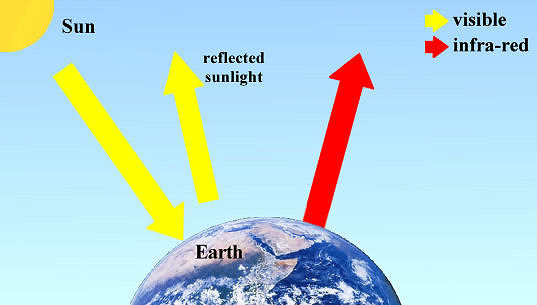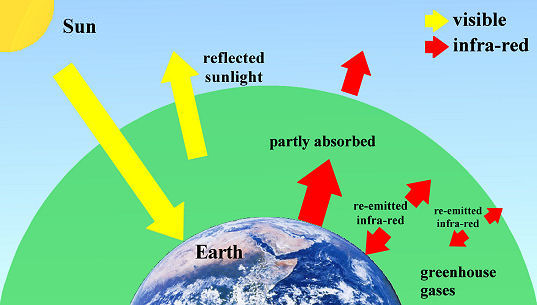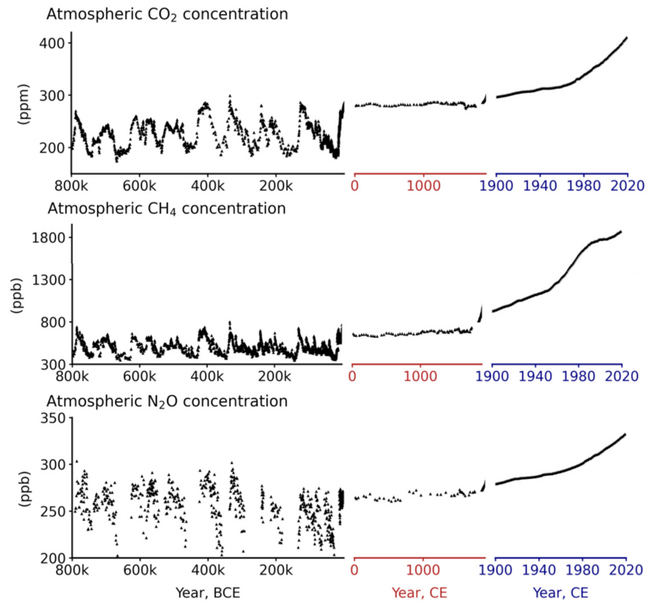Causes of Climate Change
Causes of Climate Change |
Greenhouse effect and global warming |
The heat content at the surface of the Earth is mainly derived from the Sun. When solar radiation (visible light) reaches the Earth, part of it is reflected back to space by bright surfaces (e.g. sea ice and clouds), and part of it heats up the Earth. The Earth's surface emits infra-red radiation to space and the Earth cools. If the heating and cooling of the Earth are comparable, the long-term mean temperature of the Earth will remain more or less unchanged. If the Earth has no atmosphere, laws of physics suggest that the average surface temperature of the Earth would be around -18°C.
But the Earth does have an atmosphere. Gases in the air (e.g. carbon dioxide) hinder the radiation of heat from the Earth to space, absorb part of the infra-red radiation emitted from the Earth and then re-emit energy in all directions, also in the form of infra-red radiation. Part of the infra-red radiation will escape to space but part of it will go back to the Earth, heating up the surface. This is known as the greenhouse effect, and the gases known as greenhouse gases. In the current situation, the average surface temperature of the Earth is around 15°C.
Increase in greenhouse gases concentration causes a reduction in the outgoing infrared radiation, allowing heat energy to accumulate on Earth and leading to warming of the climate system. Warming at the Earth's surface is one of the indicators of a warming climate. A rise in the Earth's surface temperature will induce many other changes. Some of these changes may even act to enhance the warming (positive feedbacks). For instance, climate warming leads to reduction of sea ice and snow cover, exposing more ocean and land surfaces. Since sea water and land have lower reflectivity than sea ice and snow, the Earth's capability of absorbing solar energy will increase. The ocean and land absorb more heat and warm, promoting further reduction of sea ice and snow cover in a vicious cycle. According to the IPCC Sixth Assessment Report, the global mean surface temperature in 2081–2100 is very likely higher than the average of 1850–1900 by 3.3-5.7°C under the very high (SSP5-8.5) greenhouse gas emissions scenario. Global warming will bring changes not just to the climate patterns and natural systems, but will also have implications for human activities, societies and civilization as we know it. |
Greenhouse gases produced by human activities |
The major greenhouse gases in the atmosphere are carbon dioxide (CO2), methane, (CH4), nitrous oxide (N2O), chlorofluorocarbons (CFCs) and ozone (O3). Although atmospheric water vapour (H2O) is also a greenhouse gas, it only plays a supporting role. Carbon dioxide is the principal control knob of Earth's temperature. For more details, please refer to the blog article "Who's in charge of global warming?" (https://www.weather.gov.hk/en/blog/00000143.htm). It is unequivocal that human influence has warmed the atmosphere, ocean and land. Owing to human activity, the concentrations of carbon dioxide, methane and nitrous oxide have all increased rapidly since 1750. The present-day carbon dioxide concentration has not been experienced for at least 2 million years, while atmospheric concentrations of methane and nitrous oxide are unprecedented in at least 800,000 years. The increase in carbon dioxide concentration is primarily due to burning of fossil fuel and deforestation, while increases in methane and nitrous oxide concentrations are due to agriculture.
Atmospheric concentrations of CO2, CH4 and N2O (Image credit: IPCC AR6)
|
|
Image credit: Figure 5.4 from Josep G. Canadell, J. G., P. M.S. Monteiro, M. H. Costa, L. Cotrim da Cunha, P. M. Cox, A. V. Eliseev, S. Henson, M. Ishii, S. Jaccard, C. Koven, A. Lohila, P. K. Patra, S. Piao, J. Rogelj, S. Syampungani, S. Zaehle, K. Zickfeld, 2021, Global Carbon and other Biogeochemical Cycles and Feedbacks. In: Climate Change 2021: The Physical Science Basis. Contribution of Working Group I to the Sixth Assessment Report of the Intergovernmental Panel on Climate Change [Masson-Delmotte, V., P. Zhai, A. Pirani, S. L. Connors, C. Péan, S. Berger, N. Caud, Y. Chen, L. Goldfarb, M. I. Gomis, M. Huang, K. Leitzell, E. Lonnoy, J. B. R. Matthews, T. K. Maycock, T. Waterfield, O. Yelekçi, R. Yu and B. Zhou (eds.)]. Cambridge University Press. In Press. » Global greenhouse gas concentrations » Global greenhouse gas emissions » Greenhouse gas emission trends of Hong Kong
|


